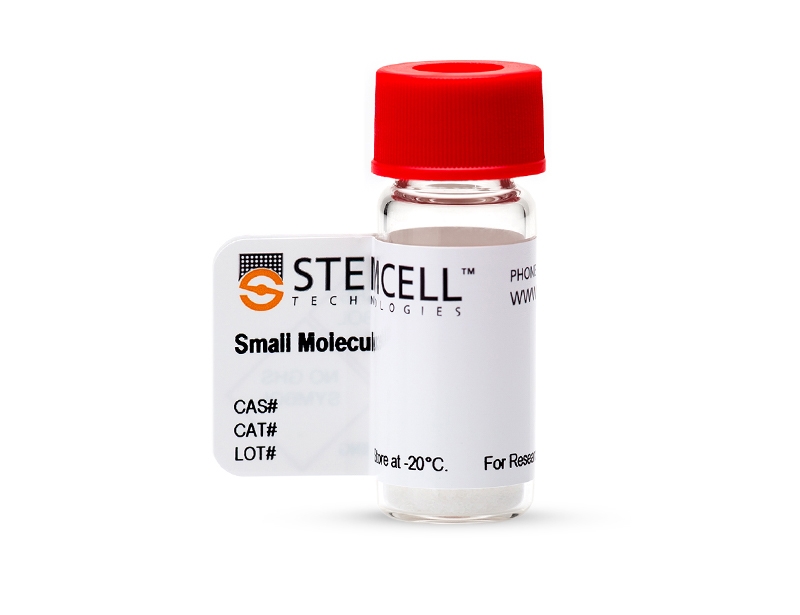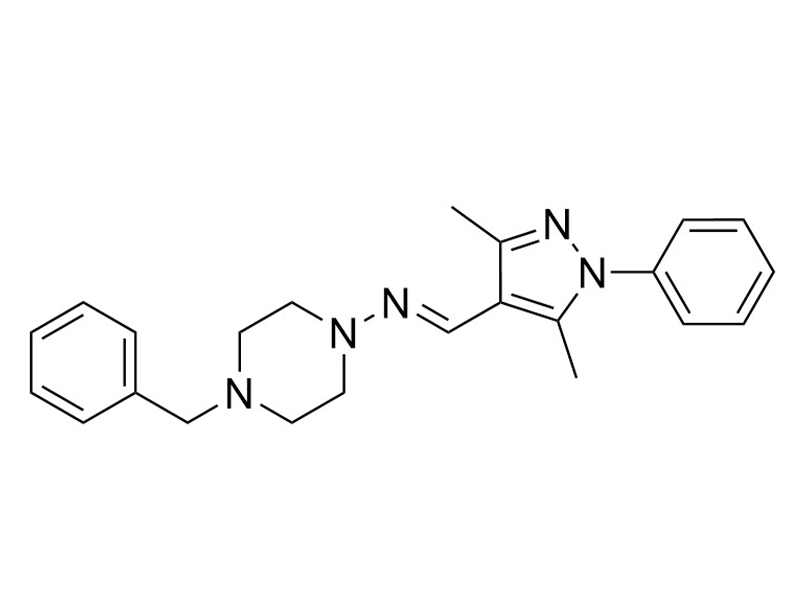SANT-1
Hedgehog pathway inhibitor; Inhibits Smoothened (SMO)
概要
SANT-1 is a cell-permeable antagonist that binds directly to Smoothened (Ki = 2.4 nM; Chen et al.; Rominger et al.) and inhibits the Sonic Hedgehog (Shh) signaling pathway.
DIFFERENTIATION
· Promotes beta cell differentiation from human embryonic stem cells (Yung et al.).
CANCER RESEARCH
· Blocks hedgehog signaling pathway leading to inhibition of tumorigenesis and proliferation in cancer lung cells (Bai et al.).
DIFFERENTIATION
· Promotes beta cell differentiation from human embryonic stem cells (Yung et al.).
CANCER RESEARCH
· Blocks hedgehog signaling pathway leading to inhibition of tumorigenesis and proliferation in cancer lung cells (Bai et al.).
Cell Type
Pancreatic Cells
Application
Differentiation
Area of Interest
Cancer Research, Stem Cell Biology
CAS Number
304909-07-7
Chemical Formula
C23H27N5
Molecular Weight
373.5 g/mol
Purity
≥ 98%
Pathway
Hedgehog
Target
SMO
技术资料
| Document Type | 产品名称 | Catalog # | Lot # | 语言 |
|---|---|---|---|---|
| Product Information Sheet | SANT-1 | 100-0538, 100-0539 | All | English |
| Safety Data Sheet | SANT-1 | 100-0538, 100-0539 | All | English |
数据及文献
Publications (4)
Nature communications 2019
Sufu- and Spop-mediated downregulation of Hedgehog signaling promotes beta cell differentiation through organ-specific niche signals.
Abstract
Abstract
Human embryonic stem cell-derived beta cells offer a promising cell-based therapy for diabetes. However, efficient stem cell to beta cell differentiation has proven difficult, possibly due to the lack of cross-talk with the appropriate mesenchymal niche. To define organ-specific niche signals, we isolated pancreatic and gastrointestinal stromal cells, and analyzed their gene expression during development. Our genetic studies reveal the importance of tightly regulated Hedgehog signaling in the pancreatic mesenchyme: inactivation of mesenchymal signaling leads to annular pancreas, whereas stroma-specific activation of signaling via loss of Hedgehog regulators, Sufu and Spop, impairs pancreatic growth and beta cell genesis. Genetic rescue and transcriptome analyses show that these Sufu and Spop knockout defects occur through Gli2-mediated activation of gastrointestinal stromal signals such as Wnt ligands. Importantly, inhibition of Wnt signaling in organoid and human stem cell cultures significantly promotes insulin-producing cell generation, altogether revealing the requirement for organ-specific regulation of stromal niche signals.
PloS one 2016
Blockade of Hedgehog Signaling Synergistically Increases Sensitivity to Epidermal Growth Factor Receptor Tyrosine Kinase Inhibitors in Non-Small-Cell Lung Cancer Cell Lines.
Abstract
Abstract
Aberrant activation of the hedgehog (Hh) signaling pathway has been implicated in the epithelial-to-mesenchymal transition (EMT) and cancer stem-like cell (CSC) maintenance; both processes can result in tumor progression and treatment resistance in several types of human cancer. Hh cooperates with the epidermal growth factor receptor (EGFR) signaling pathway in embryogenesis. We found that the Hh signaling pathway was silenced in EGFR-TKI-sensitive non-small-cell lung cancer (NSCLC) cells, while it was inappropriately activated in EGFR-TKI-resistant NSCLC cells, accompanied by EMT induction and ABCG2 overexpression. Upregulation of Hh signaling through extrinsic SHH exposure downregulated E-cadherin expression and elevated Snail and ABCG2 expression, resulting in gefitinib tolerance (P {\textless} 0.001) in EGFR-TKI-sensitive cells. Blockade of the Hh signaling pathway using the SMO antagonist SANT-1 restored E-cadherin expression and downregulate Snail and ABCG2 in EGFR-TKI-resistant cells. A combination of SANT-1 and gefitinib markedly inhibited tumorigenesis and proliferation in EGFR-TKI-resistant cells (P {\textless} 0.001). These findings indicate that hyperactivity of Hh signaling resulted in EGFR-TKI resistance, by EMT introduction and ABCG2 upregulation, and blockade of Hh signaling synergistically increased sensitivity to EGFR-TKIs in primary and secondary resistant NSCLC cells. E-cadherin expression may be a potential biomarker of the suitability of the combined application of an Hh inhibitor and EGFR-TKIs in EGFR-TKI-resistant NSCLCs.
The Journal of pharmacology and experimental therapeutics 2009 jun
Evidence for allosteric interactions of antagonist binding to the smoothened receptor.
Abstract
Abstract
The Smoothened receptor (Smo) mediates hedgehog (Hh) signaling critical for development, cell growth, and migration, as well as stem cell maintenance. Aberrant Hh signaling pathway activation has been implicated in a variety of cancers, and small-molecule antagonists of Smo have entered human clinical trials for the treatment of cancer. Here, we report the biochemical characterization of allosteric interactions of agonists and antagonists for Smo. Binding of two radioligands, [(3)H]3-chloro-N-[trans-4-(methylamino)cyclohexyl]-N-{\{}[3-(4-pyridinyl)-phenyl]methyl{\}}-1-benzothiophene-2-carboxamide (SAG-1.3) (agonist) and [(3)H]cyclopamine (antagonist), was characterized using human Smo expressed in human embryonic kidney 293F membranes. We observed full displacement of [(3)H]cyclopamine by all Smo agonist and antagonist ligands examined. N-[(1E)-(3,5-Dimethyl-1-phenyl-1H-pyrazol-4-yl)methylidene]-4-(phenylmethyl)-1-piperazinamine (SANT-1), an antagonist, did not fully inhibit the binding of [(3)H]SAG-1.3. In a functional cell-based beta-lactamase reporter gene assay, SANT-1 and N-[3-(1H-benzimidazol-2-yl)-4-chlorophenyl]-3,4,5-tris(ethyloxy)-benzamide (SANT-2) fully inhibited 3-chloro-4,7-difluoro-N-[trans-4-(methylamino)cyclohexyl]-N-{\{}[3-(4-pyridinyl)phenyl]methyl{\}}-1-benzothiophene-2-carboxamide (SAG-1.5)-induced Hh pathway activation. Detailed Schild-type" radioligand binding analysis with [(3)H]SAG-1.3 revealed that two structurally distinct Smoothened receptor antagonists SANT-1 and SANT-2 bound in a manner consistent with that of allosteric modulation. Our mechanism of action characterization of radioligand binding to Smo combined with functional data provides a better understanding of small-molecule interactions with Smo and their influence on the Hh pathway."
Proceedings of the National Academy of Sciences of the United States of America 2002 oct
Small molecule modulation of Smoothened activity.
Abstract
Abstract
Smoothened (Smo), a distant relative of G protein-coupled receptors, mediates Hedgehog (Hh) signaling during embryonic development and can initiate or transmit ligand-independent pathway activation in tumorigenesis. Although the cellular mechanisms that regulate Smo function remain unclear, the direct inhibition of Smo by cyclopamine, a plant-derived steroidal alkaloid, suggests that endogenous small molecules may be involved. Here we demonstrate that SAG, a chlorobenzothiophene-containing Hh pathway agonist, binds to the Smo heptahelical bundle in a manner that antagonizes cyclopamine action. In addition, we have identified four small molecules that directly inhibit Smo activity but are structurally distinct from cyclopamine. Functional and biochemical studies of these compounds provide evidence for the small molecule modulation of Smo through multiple mechanisms and yield insights into the physiological regulation of Smo activity. The mechanistic differences between the Smo antagonists may be useful in the therapeutic manipulation of Hh signaling.




